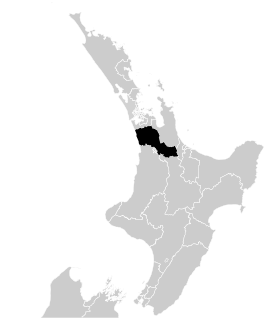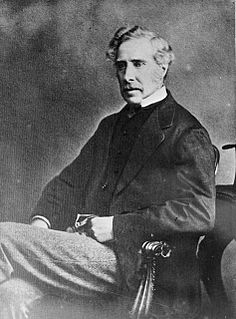Related Research Articles

The 1875–1876 New Zealand general election was held between 20 December 1875 and 29 January 1876 to elect a total of 88 MPs in 73 electorates to the 6th session of the New Zealand Parliament. The Māori vote was held on 4 and 15 January 1876. A total of 56,471 voters were registered.

The 1879 New Zealand general election was held between 28 August and 15 September 1879 to elect a total of 88 MPs to the 7th session of the New Zealand Parliament. The Māori vote was held on 8 September. A total of 82,271 (66.5%) European voters turned out to vote, plus 14,553 Māori voters. Following the election, John Hall formed a new government.

The Auckland Province was a province of New Zealand from 1853 until the abolition of provincial government in 1876.

Tauranga is a New Zealand parliamentary electorate, returning one Member of Parliament to the New Zealand House of Representatives. The current MP for Tauranga is Sam Uffindell of the National Party, who won the seat in the 2022 Tauranga by-election, following the resignation of the previous MP, Simon Bridges of the National Party.

James McGowan was a New Zealand politician of the Liberal Party.

Waikato is an electorate in the New Zealand Parliament. A Waikato electorate was first created in 1871 and an electorate by this name has existed from 1871 to 1963, 1969 to 1996, and 2008 to the present, though exact borders have often changed.

Eden, a former New Zealand parliamentary electorate, lay in the general area of the suburb of Mount Eden in the city of Auckland.
Manukau is a former New Zealand parliamentary electorate in the south Auckland Region. It existed from 1881 to 1978, with a break from 1938 to 1954. It was represented by nine Members of Parliament. Two by-elections were held in the electorate.
The former New Zealand parliamentary electorate on the western inner city of Auckland, was known as City of Auckland West from 1861 to 1890, and then Auckland West from 1905 to 1946.
Grey Valley is a former parliamentary electorate in the West Coast region of New Zealand. The electorate was created for the 1871 general election as a single-member electorate, became a two-member electorate for the 1876 general election, and was split between the single-member electorates of Greymouth and Inangahua for the 1881 general election.
Newton was a 19th-century parliamentary electorate in Auckland, New Zealand. It existed from 1861 to 1893 and was represented by seven Members of Parliament.
Hokitika is a former parliamentary electorate in the West Coast region of New Zealand, based on the town of Hokitika. It existed from 1871 to 1890 and was represented by nine members of parliament. For a time, it was one of the two-member electorates in New Zealand.
Gladstone was a parliamentary electorate in the Canterbury region of New Zealand, from 1866 to 1890.
Kaiapoi was a rural New Zealand electorate, north of Christchurch in the Canterbury region of New Zealand from 1861 to 1946. It was represented by twelve Members of Parliament.
Coleridge is a former parliamentary electorate in the Canterbury region of New Zealand. The electorate existed from the 1866 election to 1887.

William Lee Rees was an English-born New Zealand cricketer, politician and lawyer.

William Thorne Buckland was a 19th-century Member of Parliament in New Zealand.

William Kelly was an Irish migrant to New Zealand, and became a businessman, soldier and politician.
William Rowe (1819–1886) was a 19th-century Member of Parliament in the Auckland Region, New Zealand.

This is a summary of the electoral history of Sir George Grey, Prime Minister of New Zealand, (1877–1879). He represented six electorates during his political career.
References
- 1 2 Scholefield 1950, p. 164.
- ↑ Scholefield 1950, p. 130.
- ↑ "(By Telegraph). Auckland. Dec. 22". Vol. XXIII, no. 1159. North Otago Times. 23 December 1875. p. 2. Retrieved 11 April 2010.
- ↑ "THE ELECTIONS". Vol. XXXII, no. 5708. Daily Southern Cross. 8 January 1876. p. 3. Retrieved 13 April 2010.
- ↑ "The Thames election : petition against sir George Grey's election". Vol. XXXII, no. 5724. Daily Southern Cross. 1 February 1876. p. 3. Retrieved 13 April 2010.
- ↑ "Sir George Grey and the seats for the Thames and City West". Vol. XXXII, no. 5205. Daily Southern Cross. 17 June 1876. p. 3. Retrieved 13 April 2010.
- ↑ "New Zealand Parliament". Vol. XXIV, no. 2427. Taranaki Herald. 12 July 1876. p. 3. Retrieved 13 April 2010.
- ↑ "Parliamentary". Vol. IV, no. 401. Bay Of Plenty Times. 15 July 1876. Retrieved 13 April 2010.
- ↑ "Thames election". Bay Of Plenty Times. Vol. VIII, no. 777. 4 September 1879. p. 3. Retrieved 7 January 2011.
- ↑ Scholefield 1950, p. 110.
- ↑ Scholefield 1950, p. 138.
- ↑ Scholefield 1925, p. 107.
- ↑ "The Thames Election". Thames Star. Vol. XXII, no. 6749. 5 December 1890. p. 2. Retrieved 8 January 2011.
- ↑ "Election After-thoughts". Observer. Vol. X, no. 624. 13 December 1890. p. 3. Retrieved 8 January 2011.
- ↑ Scholefield 1950, p. 99.
- ↑ Scholefield 1925, pp. 80, 122.
- ↑ Scholefield 1925, p. 143.
- ↑ "Thames News : The Thames Election". Thames Star. Vol. XLVI, no. 10128. 9 December 1911. p. 2. Retrieved 8 January 2011.
- ↑ Scholefield 1925, p. 135.
- ↑ Scholefield 1925, p. 137.
- ↑ Scholefield 1925, p. 144.
- ↑ Scholefield 1925, p. 164.
- ↑ "The General Election, 1943". National Library. 1944. p. 11. Retrieved 28 March 2014.
- ↑ "Electoral". The New Zealand Herald . Vol. 80, no. 24764. 11 December 1943. p. 6. Retrieved 16 May 2017.
- ↑ "The General Election, 1938". National Library. 1939. pp. 1–6. Retrieved 8 February 2012.
- ↑ The General Election, 1935. National Library. 1936. pp. 1–35. Retrieved 3 August 2013.
- ↑ The General Election, 1931. Government Printer. 1932. p. 5. Retrieved 2 November 2014.
- ↑ "Reform Triumph". The Northern Advocate . 18 June 1925. p. 5. Retrieved 15 December 2014.
- ↑ Skinner, W. A. G. (1929). The General Election, 1928. Government Printer. p. 5. Retrieved 27 February 2020.
- ↑ "Public notices". Waihi Daily Telegraph . Vol. XXV, no. 7769. 1 November 1928. p. 3. Retrieved 27 February 2020.
- ↑ "The Thames Election". Thames Star. Vol. XLV, no. 10633. 5 February 1909. p. 2. Retrieved 23 March 2016.
- ↑ "Thames By-Election". The Press . Vol. LXV, no. 13342. 6 February 1909. p. 9. Retrieved 23 March 2016.
- ↑ "Success of Government Candidate". Thames Star. Vol. XLV, no. 10627. 29 January 1909. p. 2. Retrieved 23 March 2016.
- ↑ "The General Election, 1899". Wellington: Appendix to the Journals of the House of Representatives. 19 June 1900. p. 1. Retrieved 12 February 2014.
- ↑ "Electoral District of Thames". Thames Advertiser. Vol. XXIX, no. 9510. 13 December 1899. p. 3. Retrieved 20 February 2014.
- ↑ "Electoral District of Thames". Thames Advertiser. Vol. XXVIII, no. 8607. 10 December 1896. p. 3. Retrieved 9 January 2014.
- ↑ "The General Election, 1890". National Library. 1891. Retrieved 25 February 2012.
- ↑ "Declaration of the Poll at Thames". The New Zealand Herald . Vol. XIII, no. 4419. 12 January 1876. p. 3. Retrieved 19 November 2016.